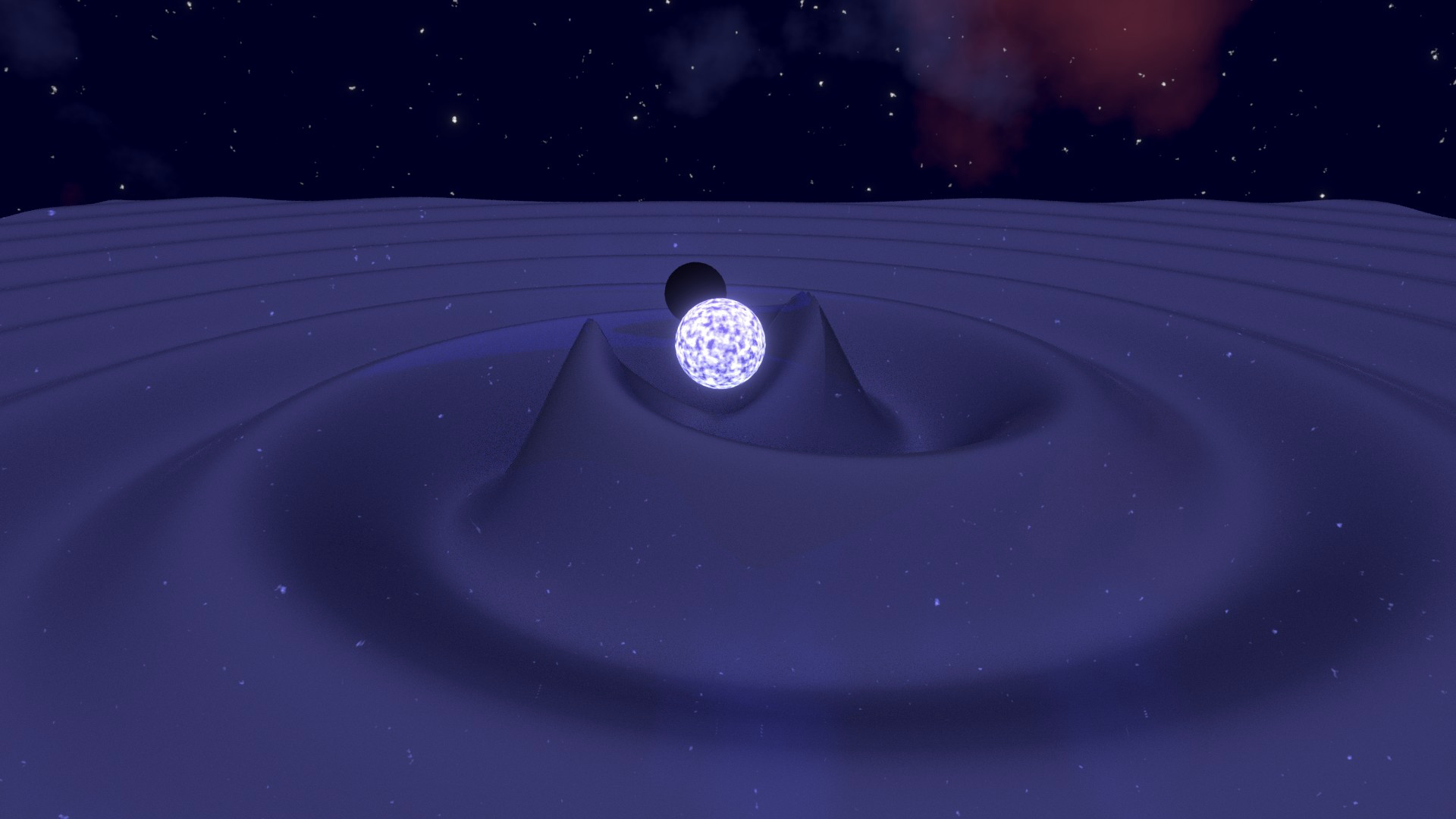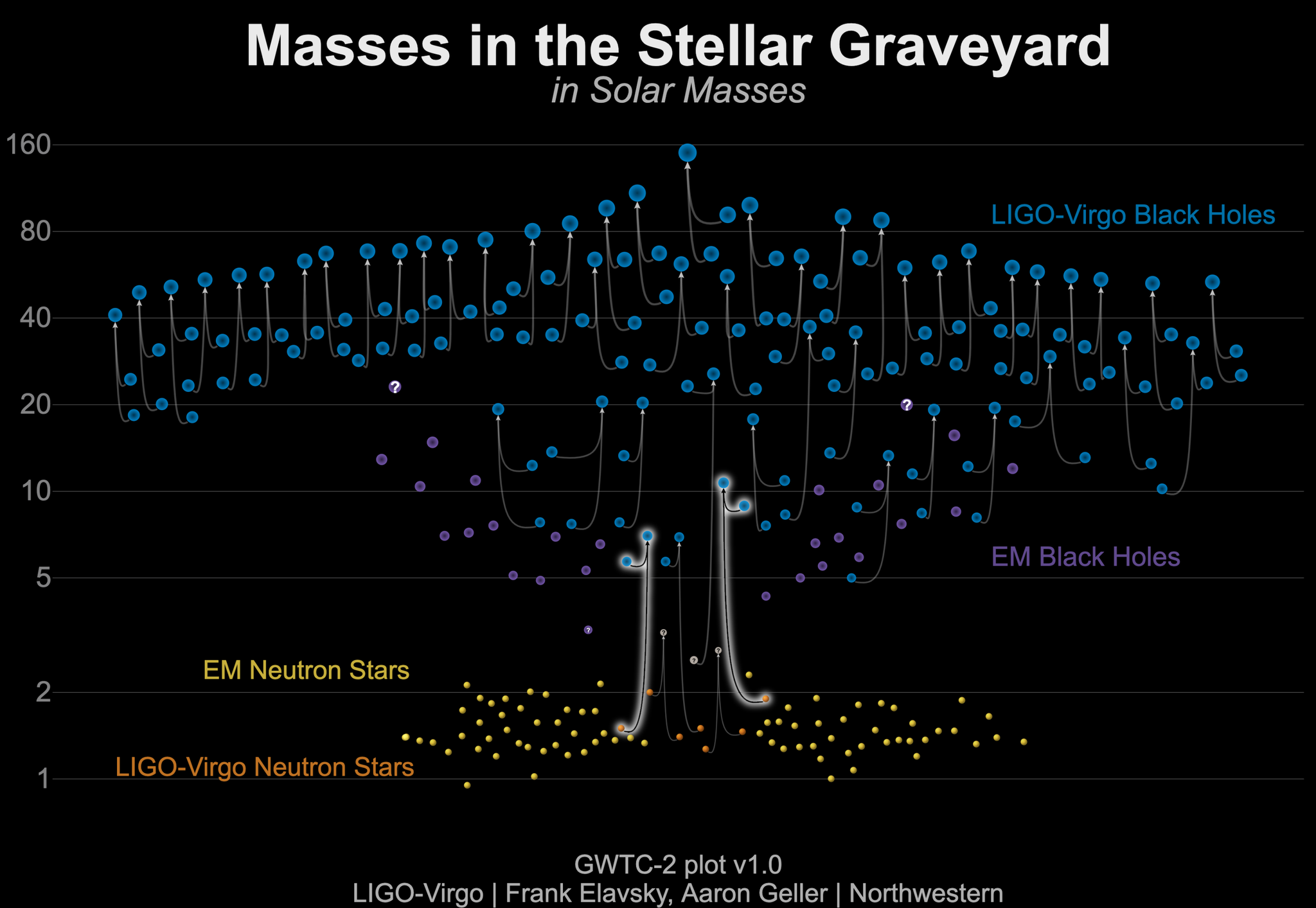Scientists catch 1st glimpse of a black hole swallowing a neutron star
"These were not events where the black holes munched on the neutron stars like the Cookie Monster and flung bits and pieces about," one physicist said.
After more than four years of exploring a menagerie of cosmic happenings through gravitational waves, scientists have finally spotted the third expected variety of collision — twice.
The new flavor of collision includes one black hole and one neutron star, making it a mash-up of sorts. Scientists have observed dozens of mergers of pairs of black holes, and a couple mergers of pairs of neutron stars, the superdense stellar corpses. But a crash between a black hole and neutron star, while predicted by scientists, had not been definitively detected.
Now, researchers say they have done just that, observing the unique ripples in space-time caused by such a collision.
"With this new discovery of neutron star-black hole mergers outside our galaxy, we have found the missing type of binary," Astrid Lamberts, a CNRS researcher at Observatoire de la Côte d'Azur in France, said in a statement. "We can finally begin to understand how many of these systems exist, how often they merge, and why we have not yet seen examples in the Milky Way."
Related: Hunting gravitational waves: The LIGO laser interferometer project in photos

The two new detections both came in January 2020, just 10 days apart, and the collisions are now known as GW200105 and GW200115 for the dates they were observed. One was detected by both twin Laser Interferometer Gravitational-wave Observatory (LIGO) detectors and Europe's similar Virgo detector, the other by only one of the LIGO detectors and Virgo. (The partnership now also includes a detector in Japan called KAGRA, but that facility began observations only in February 2020.)
GW200115 was particularly well detected and observed by all three facilities. Scientists believe that it involved a black hole nearly six times the mass of our sun devouring a neutron star with a mass half again larger than our sun, and that the merger took place between 650 million and 1.5 billion light-years away
Breaking space news, the latest updates on rocket launches, skywatching events and more!
GW200105 wasn't detected as definitively, but scientists suspect it was a merger between a black hole about nine times the mass of the sun and a neutron star about twice as massive as the sun about 550 million and 1.3 billion light-years away.

Scientists aren't sure yet whether these mixed mergers create a visible light signal (as neutron star pairs merging seem to do) or not (as in the case of binary black hole mergers).
Astronomers couldn't match either of these new gravitational-wave detections with observations of light waves, but that doesn't necessarily mean there was no such corresponding flash. For the less precise detection, scientists could only narrow down the location of the source to about 17% of the sky; for the more precise detection, scientists were still confronting an area the equivalent of 2,900 full moons. Besides, at such vast distances from the collisions, any light would have been extremely dim by the time it reached Earth anyway.
However, the scientists do suspect that at least for these particular mergers, there was no light signal to see.
"These were not events where the black holes munched on the neutron stars like the Cookie Monster and flung bits and pieces about," Patrick Brady, a physicist at the University of Wisconsin-Milwaukee and current spokesperson of the LIGO Scientific Collaboration, said in a statement. "That 'flinging about' is what would produce light, and we don't think that happened in these cases." (The messy eating is also called tidal disruption.)

These two events mark the first times scientists have seen a merger and been confident that it represented a mixed pair. For two previous detections, however, the same scenario is a possibility, although not one that astronomers can confirm. One of those events, detected in August 2019, represents a large black hole with what is either the largest known neutron star or the smallest known black hole. Another event detected four months earlier may be a mixed pair merging — but could just represent noise in the detectors.
Given the two January 2020 observations, scientists now predict that one merger between a black hole and a neutron star occurs once per month within one billion light-years of Earth.
Scientists have two theories for how such mergers occur. One is that each member of a binary star independently goes supernova, exploding and forming two dense remnants that eventually merge. The other theory suggests that disparate stars experience supernova explosions, then establish a binary relationship.
The two new collision observations aren't enough to determine what's going on, but scientists do hope that eventually, gravitational wave detections will solve the puzzle.
"There's still so much we don't know about neutron stars and black holes — how small or big they can get, how fast they can spin, how they pair off into merger partners," Maya Fishbach, a postdoc at Northwestern University in Illinois and a coauthor on the study, said in a university statement. "With future gravitational wave data, we will have the statistics to answer these questions, and ultimately learn how the most extreme objects in our universe are made."
The twin LIGO detectors, Virgo and KAGRA are all undergoing preparations for the partnership's fourth observing run, which is scheduled to begin next summer. Scientists say that work could see the partnership detecting one gravitational wave signal every day, opening scientists to immensely more information about what is taking place across the cosmos, as in these dramatic mergers.
"Each collision isn't just the coming together of two massive and dense objects. It's really like Pac-Man, with a black hole swallowing its companion neutron star whole," Susan Scott, a physicist at the Australian National University and co-author on the study, said in a university statement. "These collisions have shaken the universe to its core and we've detected the ripples they have sent hurtling through the cosmos."
The results are described in a paper published on June 29 in the journal The Astrophysical Journal Letters.
Email Meghan Bartels at mbartels@space.com or follow her on Twitter @meghanbartels. Follow us on Twitter @Spacedotcom and on Facebook.

Meghan is a senior writer at Space.com and has more than five years' experience as a science journalist based in New York City. She joined Space.com in July 2018, with previous writing published in outlets including Newsweek and Audubon. Meghan earned an MA in science journalism from New York University and a BA in classics from Georgetown University, and in her free time she enjoys reading and visiting museums. Follow her on Twitter at @meghanbartels.
